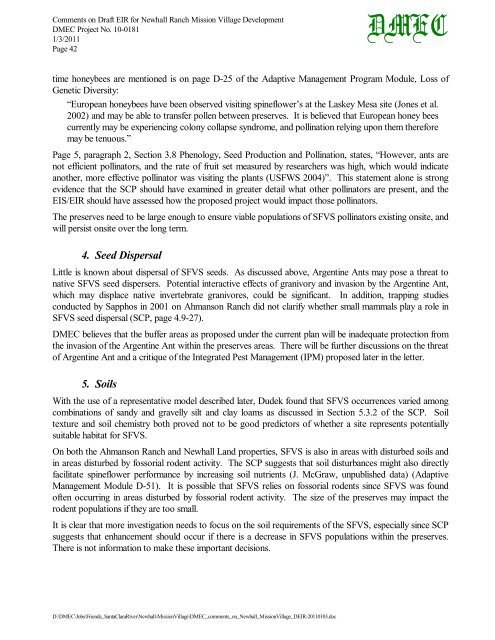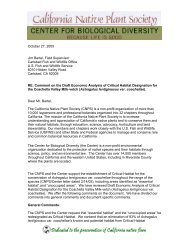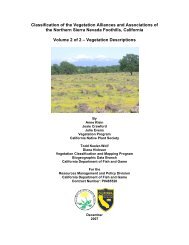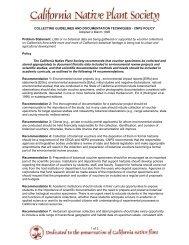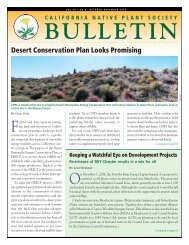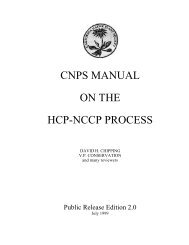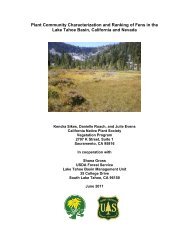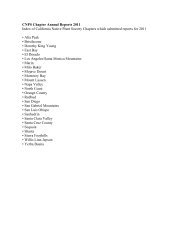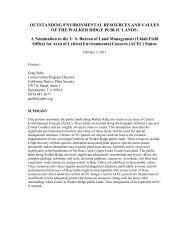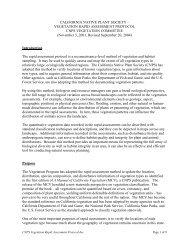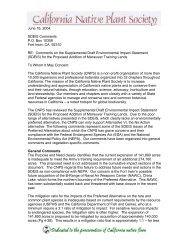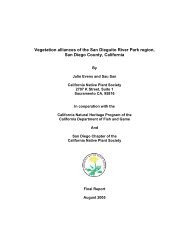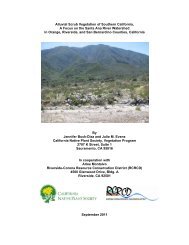David Magney Environmental Consulting - California Native Plant ...
David Magney Environmental Consulting - California Native Plant ...
David Magney Environmental Consulting - California Native Plant ...
Create successful ePaper yourself
Turn your PDF publications into a flip-book with our unique Google optimized e-Paper software.
Comments on Draft EIR for Newhall Ranch Mission Village Development<br />
DMEC Project No. 10-0181<br />
1/3/2011<br />
Page 42<br />
D:\DMEC\Jobs\Friends_SantaClaraRiver\Newhall-MissionVillage\DMEC_comments_on_Newhall_MissionVillage_DEIR-20110103.doc<br />
DMEC<br />
time honeybees are mentioned is on page D-25 of the Adaptive Management Program Module, Loss of<br />
Genetic Diversity:<br />
“European honeybees have been observed visiting spineflower’s at the Laskey Mesa site (Jones et al.<br />
2002) and may be able to transfer pollen between preserves. It is believed that European honey bees<br />
currently may be experiencing colony collapse syndrome, and pollination relying upon them therefore<br />
may be tenuous.”<br />
Page 5, paragraph 2, Section 3.8 Phenology, Seed Production and Pollination, states, “However, ants are<br />
not efficient pollinators, and the rate of fruit set measured by researchers was high, which would indicate<br />
another, more effective pollinator was visiting the plants (USFWS 2004)”. This statement alone is strong<br />
evidence that the SCP should have examined in greater detail what other pollinators are present, and the<br />
EIS/EIR should have assessed how the proposed project would impact those pollinators.<br />
The preserves need to be large enough to ensure viable populations of SFVS pollinators existing onsite, and<br />
will persist onsite over the long term.<br />
4. Seed Dispersal<br />
Little is known about dispersal of SFVS seeds. As discussed above, Argentine Ants may pose a threat to<br />
native SFVS seed dispersers. Potential interactive effects of granivory and invasion by the Argentine Ant,<br />
which may displace native invertebrate granivores, could be significant. In addition, trapping studies<br />
conducted by Sapphos in 2001 on Ahmanson Ranch did not clarify whether small mammals play a role in<br />
SFVS seed dispersal (SCP, page 4.9-27).<br />
DMEC believes that the buffer areas as proposed under the current plan will be inadequate protection from<br />
the invasion of the Argentine Ant within the preserves areas. There will be further discussions on the threat<br />
of Argentine Ant and a critique of the Integrated Pest Management (IPM) proposed later in the letter.<br />
5. Soils<br />
With the use of a representative model described later, Dudek found that SFVS occurrences varied among<br />
combinations of sandy and gravelly silt and clay loams as discussed in Section 5.3.2 of the SCP. Soil<br />
texture and soil chemistry both proved not to be good predictors of whether a site represents potentially<br />
suitable habitat for SFVS.<br />
On both the Ahmanson Ranch and Newhall Land properties, SFVS is also in areas with disturbed soils and<br />
in areas disturbed by fossorial rodent activity. The SCP suggests that soil disturbances might also directly<br />
facilitate spineflower performance by increasing soil nutrients (J. McGraw, unpublished data) (Adaptive<br />
Management Module D-51). It is possible that SFVS relies on fossorial rodents since SFVS was found<br />
often occurring in areas disturbed by fossorial rodent activity. The size of the preserves may impact the<br />
rodent populations if they are too small.<br />
It is clear that more investigation needs to focus on the soil requirements of the SFVS, especially since SCP<br />
suggests that enhancement should occur if there is a decrease in SFVS populations within the preserves.<br />
There is not information to make these important decisions.


